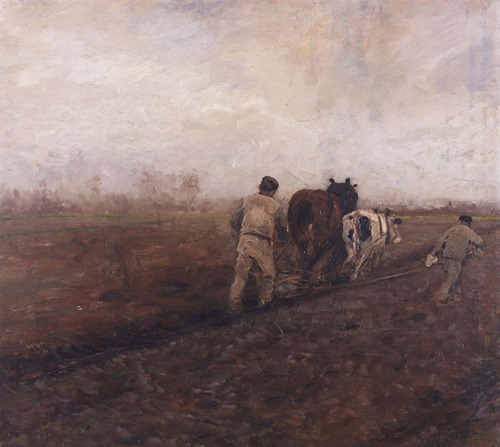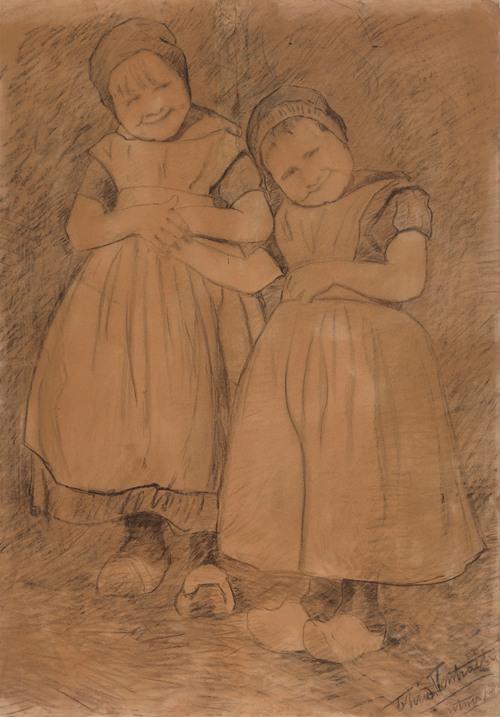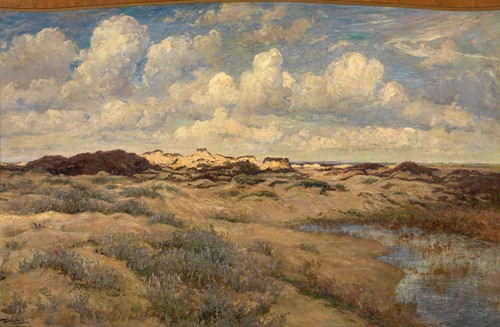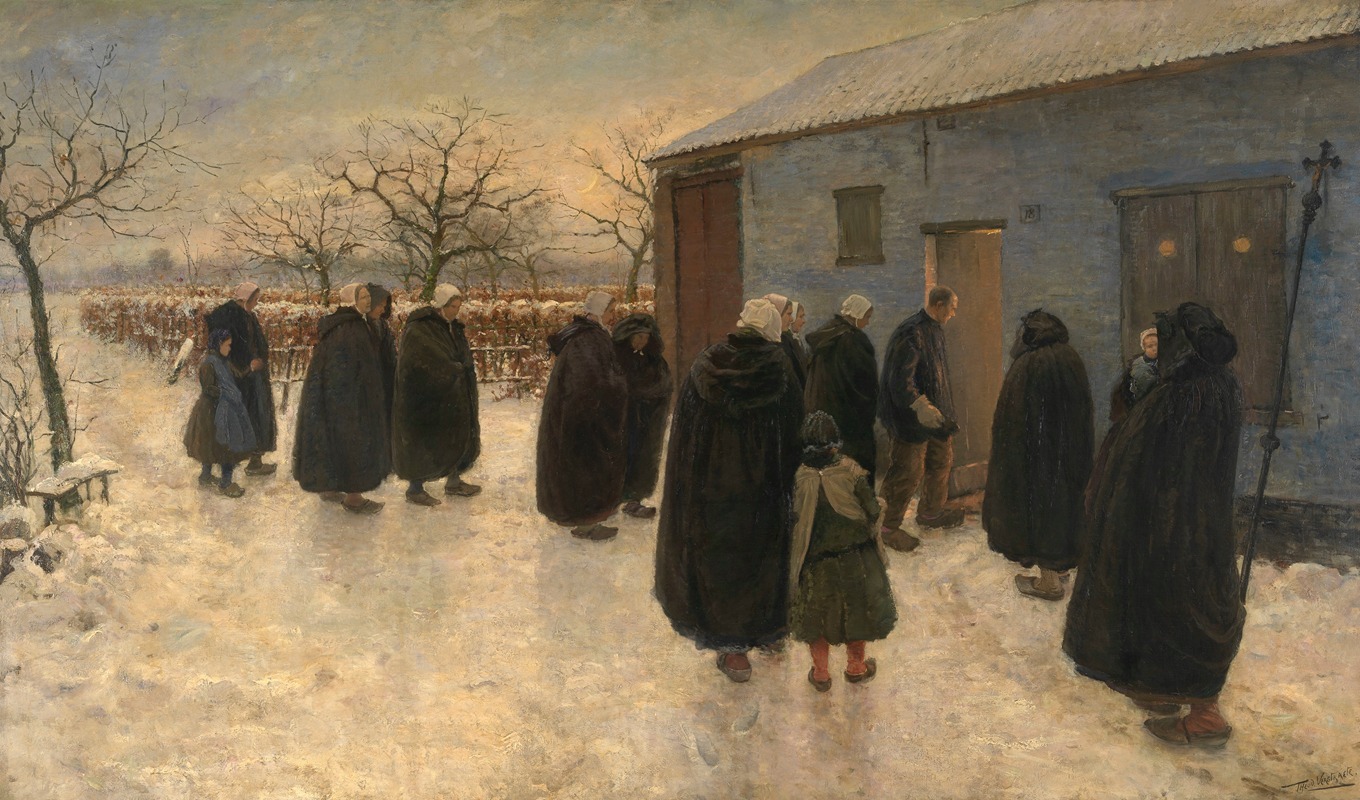
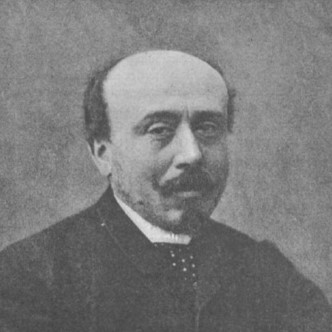
Theodoor Verstraete, also spelled Theodor Verstraete and Théodore Verstraete was a Belgian Realist painter and printmaker who is known for his landscapes depicting life in the countryside as well as his paintings of the Belgian coastal landscape. He has been called the 'poet of rural life' who depicted the humble life of the people in the countryside with empathy.
Verstraete was born in Ghent, Belgium, on 5 January 1850. His father and mother moved to Antwerp in 1852. His father was the second conductor of the 'Nationaal Toneel" (National Theatre) in Antwerp while his mother, Julie Verstraete-Lacquet, was a popular actress. The family later moved to Brussels. Verstraete initially showed an inclination for music and accompanied his parents on their theatre tours including a trip in 1860 to the Netherlands. He was also keen on drawing. In 1867 he commenced his studies at the Royal Academy of Fine Arts of Antwerp. In the graphics department, headed by Jozef Bal, Verstraete developed his drawing skills and also learned the etching technique, which he would use throughout his career.
From 1867 he attended the painting class at the Antwerp Academy, which was headed by Jacob Jacobs. The classmates of Verstraete included Emile Claus, Jef Lambeaux, Edgard Farasyn and Henri Houben. From 1873 to 1878 Verstraete attended the free workshop of Jacob Jacobs, which was linked to the Academy. That year he got married. He relied for his finances on aid from his mother as well as his work as a drummer and decorative painter at the theatre. At the time he was living in Brussels.
Theodoor Verstraete showed his first canvases at the Antwerp Salon of 1876 or 1877. From that time onwards, he regularly contributed to exhibitions. He achieved his first success in 1882 with his painting Dusk, which was awarded an honorable mention in Paris and a gold medal in Antwerp.
In 1878 Verstraete left the Academy and went to work the next year in a picturesque house in Brasschaat, near Antwerp. His house was built in the middle of nature in the Campine region of Belgium. From here he traveled around in his caravan to paint the surrounding landscapes. He only visited his family, presumably still living in Brussels, in the weekends. Verstraete was called the 'painter of Brasschaat' and other painters working with him or receiving training from him were considered to be members of the so-called 'School of Brasschaat' of landscape painting. Jan Frans Simons, Frans Van Ballaer and Jules Guiette were deemed to be members of this school. Evert Pieters and Rosa Leigh are also regarded as pupils of Theodoor Verstraete.
In 1883 Verstraete was one of the 20 original members of the group of the 'Les XX' (The Twenty), an association of 20 progressive artists in Brussels. He left the group two years later, probably because of his more conservative style, which was not in line with what the other artists in the group were creating. Verstraete was in 1883 a co-founder of the Antwerp group of artists called 'Wees U Zelf' ('Be yourself'). The manifest of the group drafted by Piet Verhaert argued for maintaining the tradition. Other members included Frans Van Kuyck, Eugène Joors, Edgard Farasyn and Emile Claus. Verstraete was in 1891 a co-founder in Antwerp of the artist association 'De XIII', which aimed to liberate art of the reigning academism. It planned to organize annual exhibitions (salons) in Antwerp as well as group exhibitions. During its existence the association, which was disbanded in 1899, organized three salons.
The financial situation of Verstraete improved after he was introduced in 1886 to art collector and patron Henri Van Cutsem. Van Cutsem encouraged Verstraete to travel to various places in the Netherlands such as Hansweert, Leiden, Utrecht and Schoore in Zeeland, where he etched and painted. Theodoor Verstraete also spent time in Blankenberge on the Belgian coast where Van Cutsem owned a villa and invited his artist friends to visit. Verstraete was fascinated with the mobile spectacle of water and air near the sea. While the relationship with Van Cutsem resulted in a considerable improvement of Verstraete's finances, he was in 1893 struck by a stroke, which possibly led to blindness and inability to speak. This signaled the end of the artistic career of Verstraete.
The destitute Verstraete could thereafter only survive financially through the support of his patron Henri Van Cutsem, who gave him after 1904 a monthly stipend. Van Cutsem also regularly bought from Verstraete paintings, which he later returned to the artist. The retrospective exhibitions of 1895 in Zaal Verlat and in 1906 organized by Kunst van Heden (Art of Today), which also included works by Willem Linnig the Younger, were also a welcome source of income.
During his last years Theodoor Verstraete continued to suffer from ill health and mental disability. After he died on 8 January 1907 he was interred next to Hendrik Conscience at the honorary park of the Kiel cemetery in Antwerp. On 15 April 1942 his remains were transferred to the honorary park of the Schoonselhof cemetery in Antwerp. In 1909 a statue and monument of Verstraete was erected in the Stadspark ('City park') of Antwerp. It was sculpted and donated by Guillaume Charlier.
